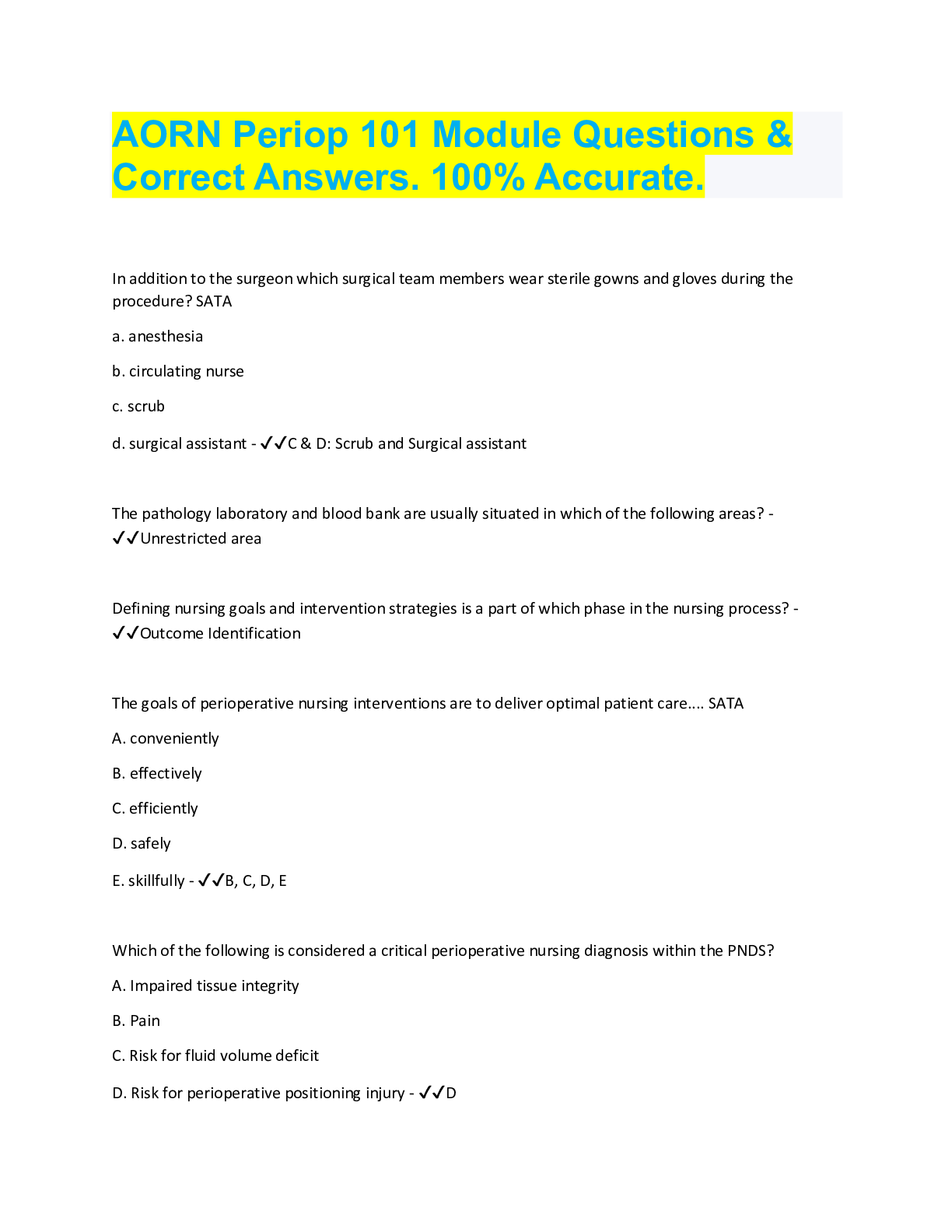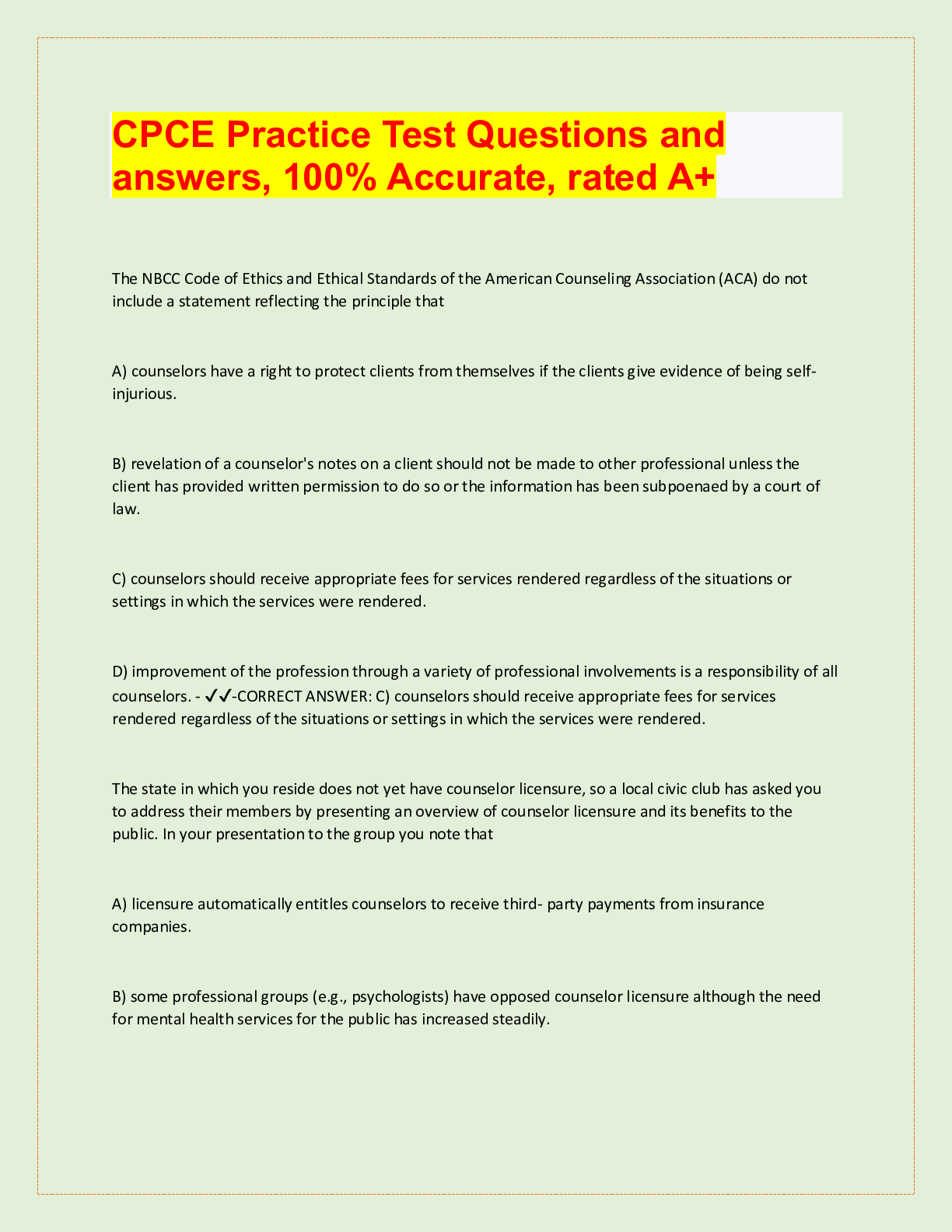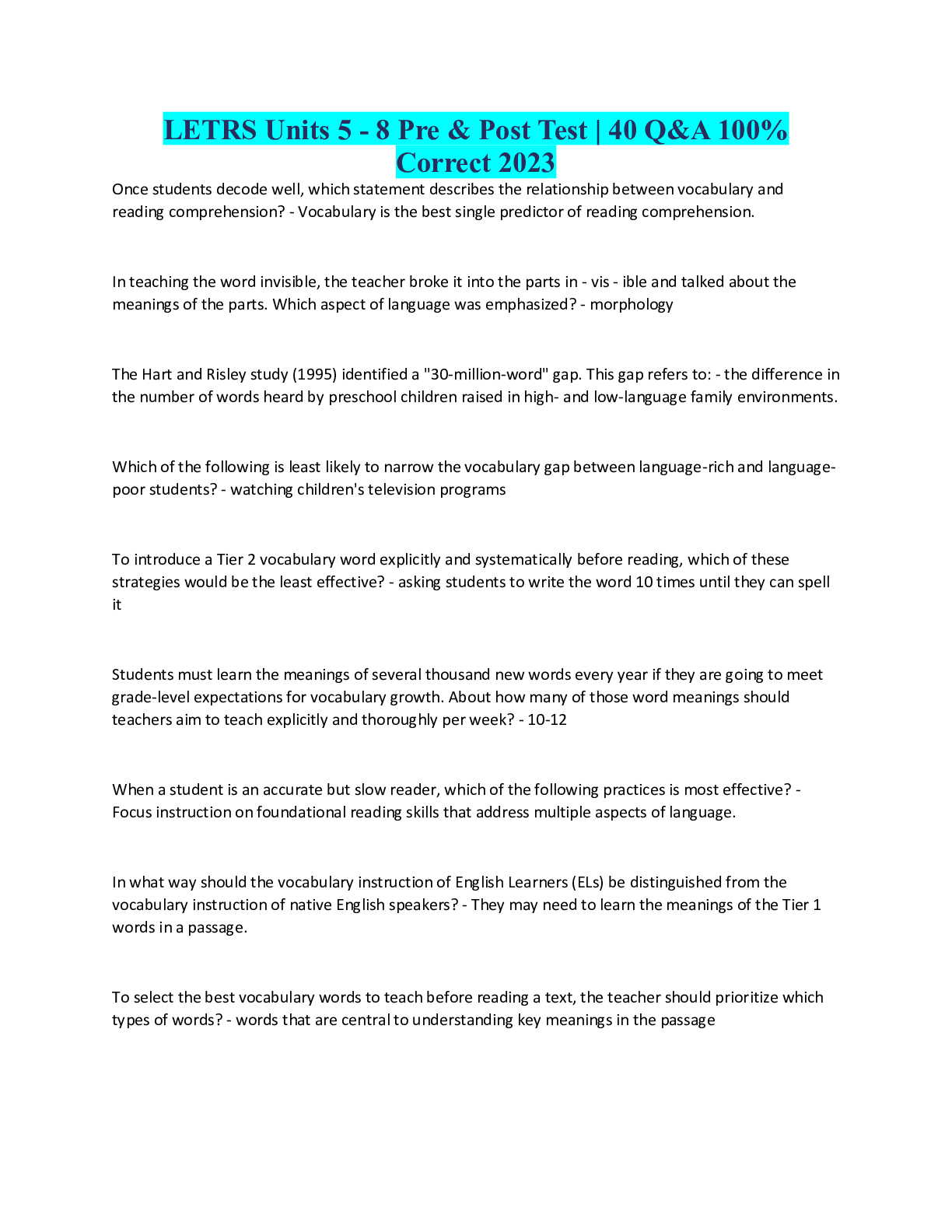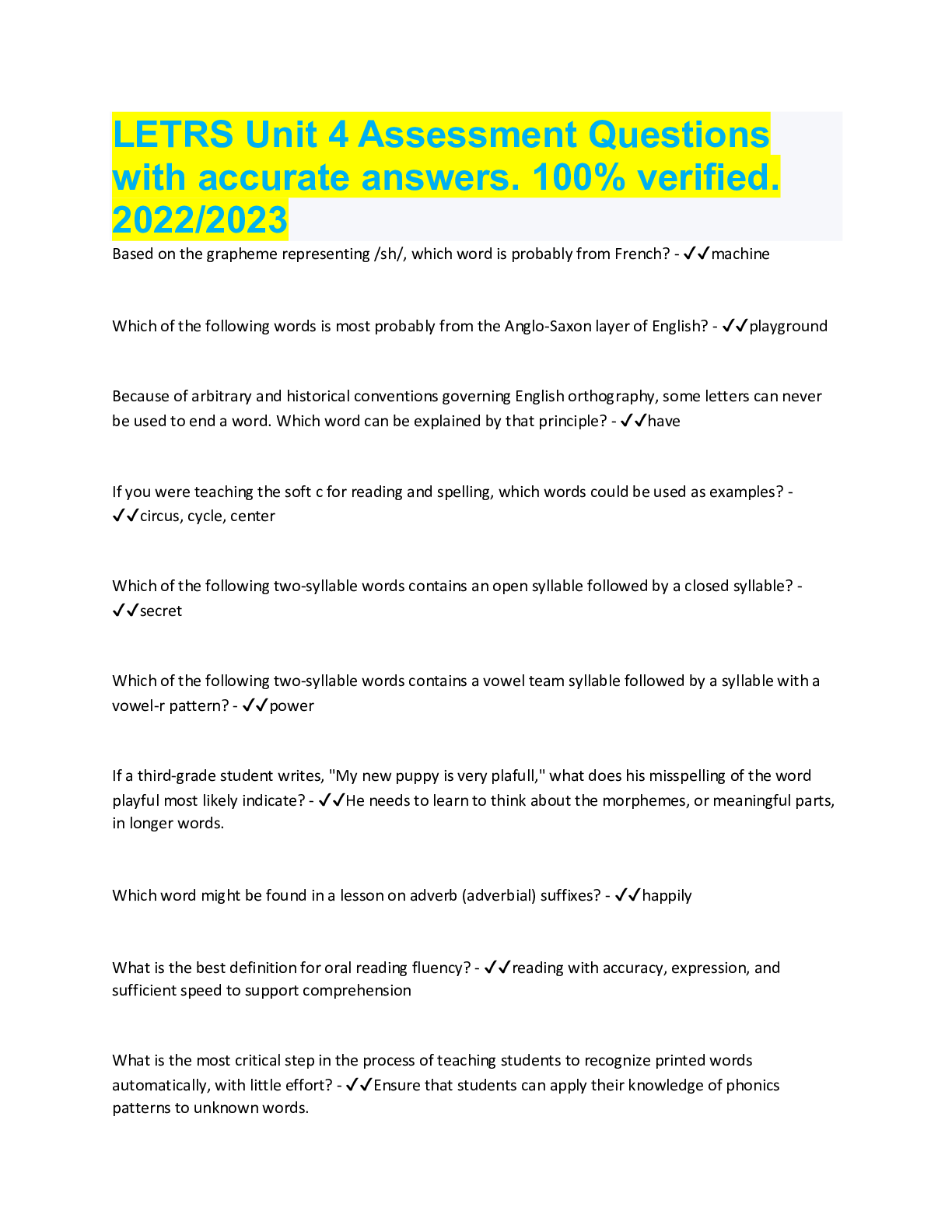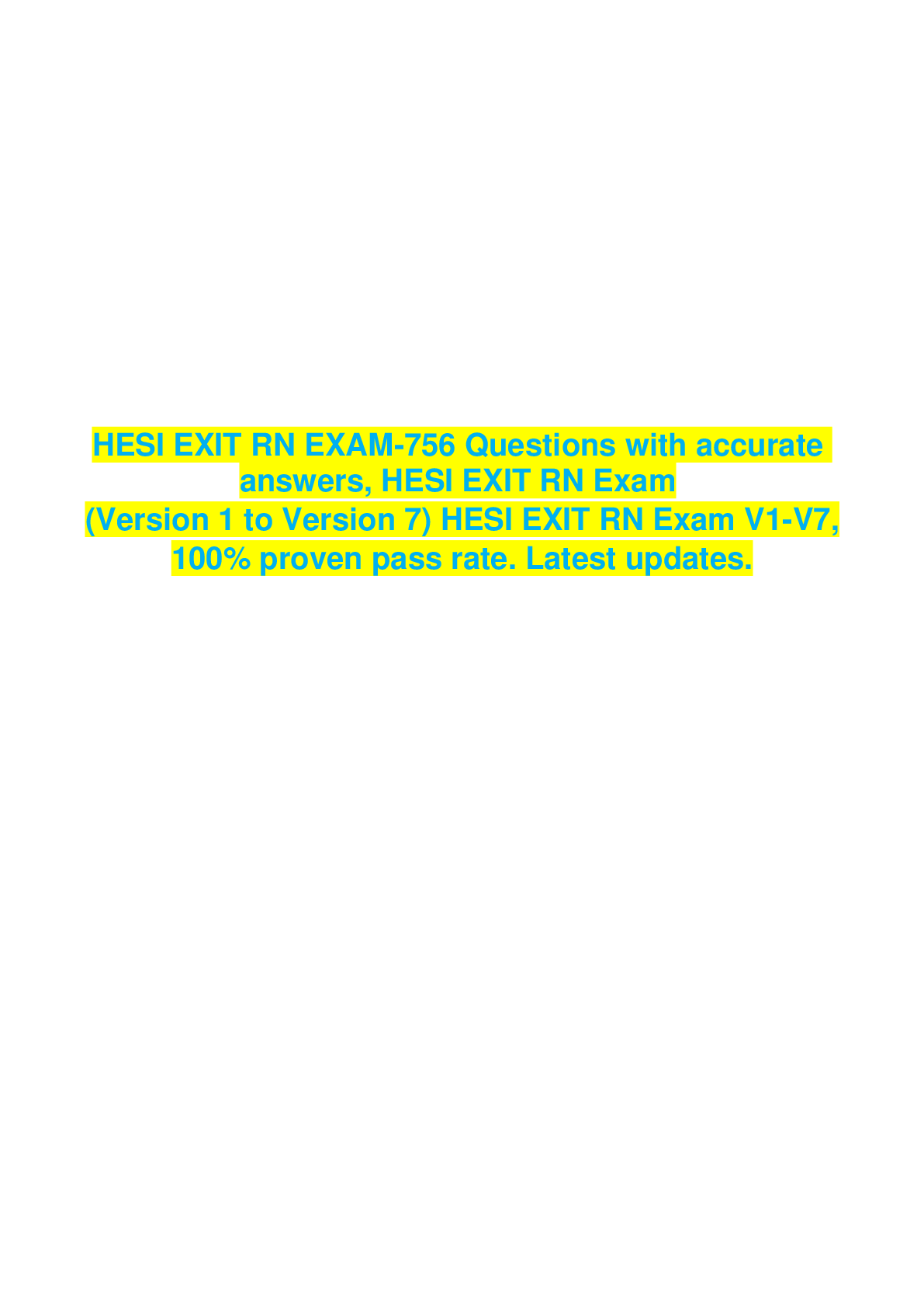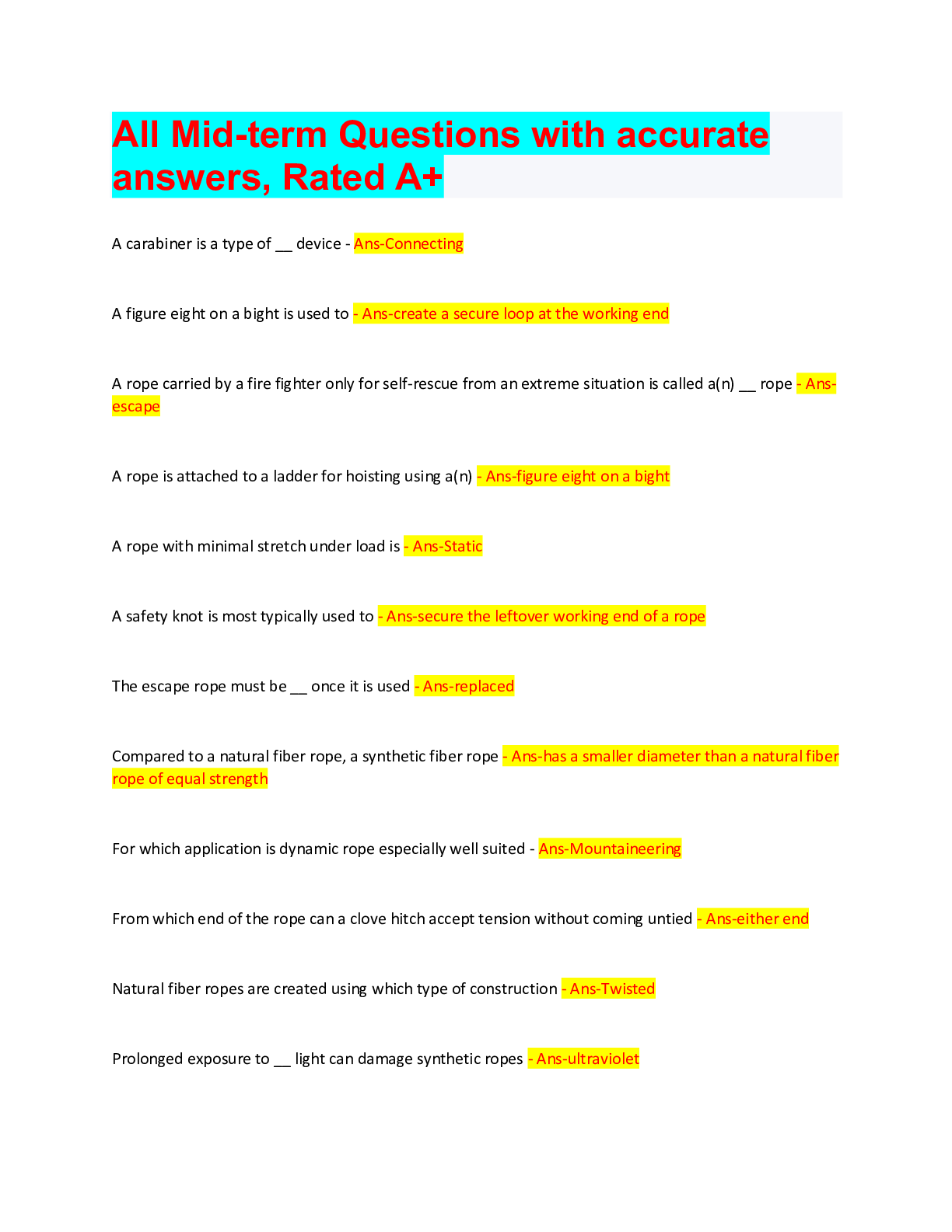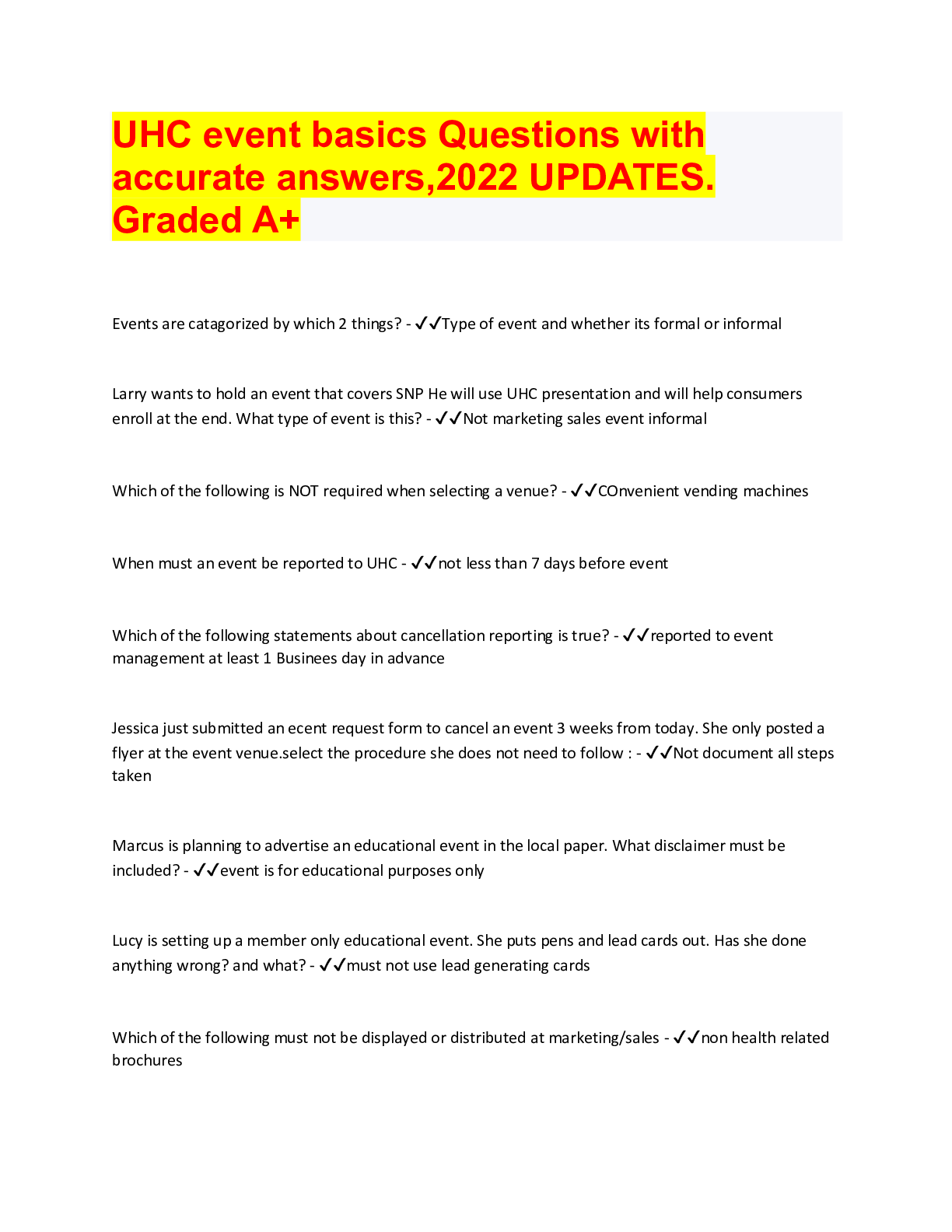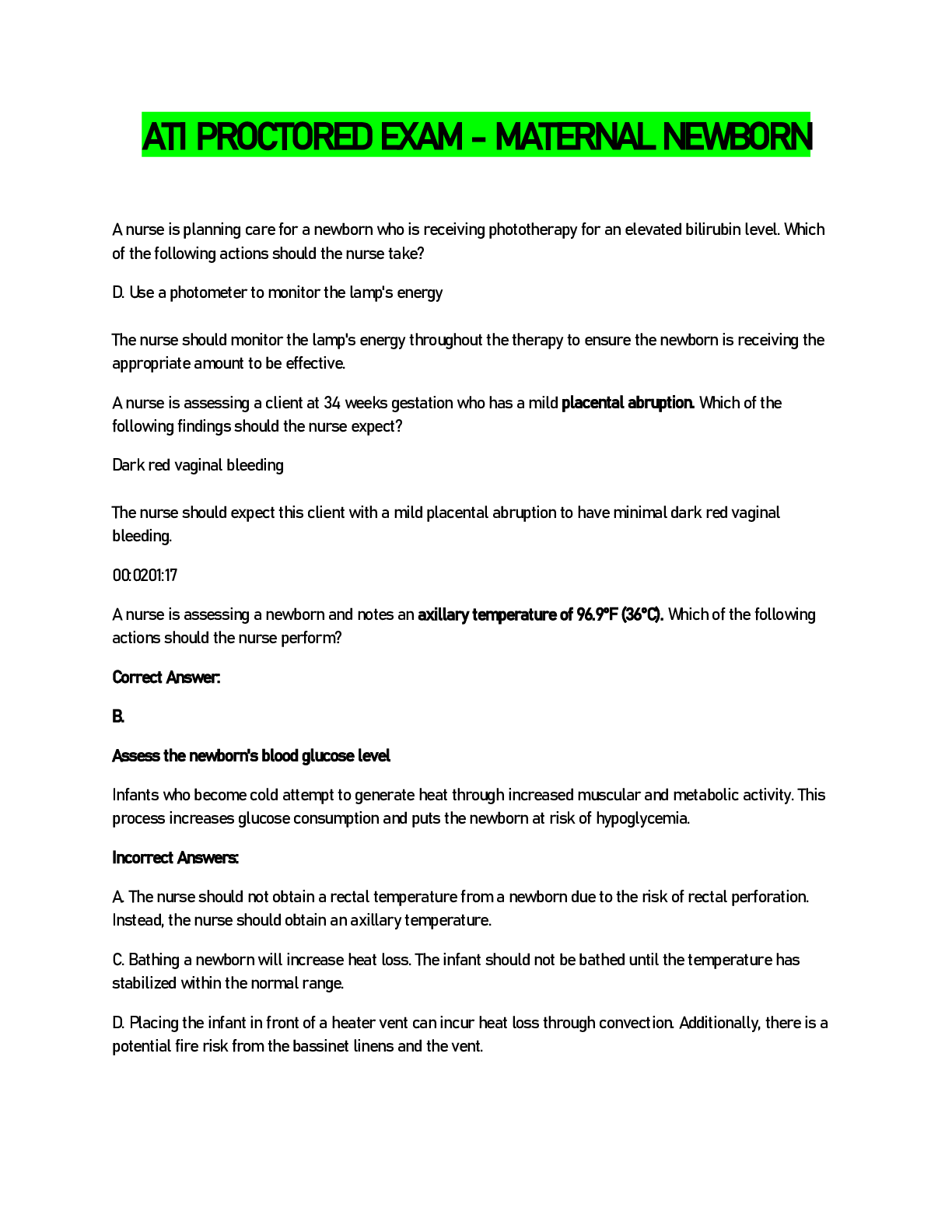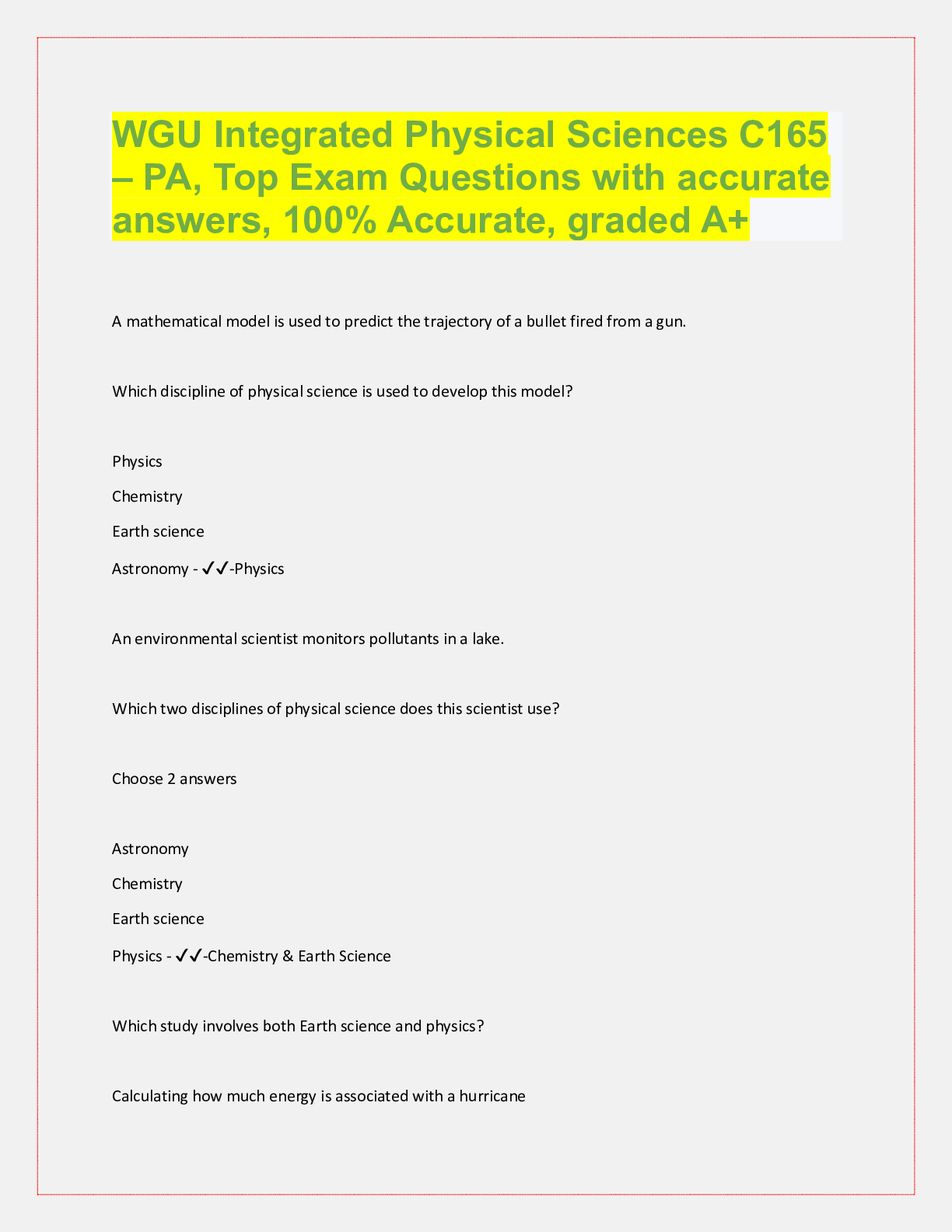*NURSING > QUESTIONS & ANSWERS > APhA Immunization Self-Study Evaluation Questions with accurate answers, rated A+ (All)
APhA Immunization Self-Study Evaluation Questions with accurate answers, rated A+
Document Content and Description Below
APhA Immunization Self-Study Evaluation Questions with accurate answers, rated A+ If a vial of influenza vaccine is left out of the refrigerator on the pharmacy counter overnight, what should be ... done with the vaccine? - ✔✔LO 5.4; Module 5— Vaccine Storage and Handling. If a vaccine has been exposed to temperatures outside the recommended range, the vaccine should be quarantined and stored in the refrigerator or freezer (as appropriate based on where the vaccine should usually be stored). In the case, the IIV should be placed back in the refrigerator. This quarantined vaccine should be clearly marked "do not use" and the manufacturer should be contacted for further guidance. Pharmacists should document each of these steps any time there is a break in the cold chain. The presence of fever, diffuse maculopapular rash, and Koplik spots are characteristic of which of the following diseases? - ✔✔Module 3—Measles, Mumps, Rubella. Measles The classic symptoms of measles include fever, cough, coryza (runny nose), conjunctivitis, Koplik spots (a bluish-white rash on mucous membranes, especially the mouth), followed by the development of a maculopapular rash approximately 14 days after exposure. Individuals infected with mumps may not have symptoms. Others may have nonspecific symptoms, such as headache, fever, myalgia, and malaise. About 30% to 40% of individuals may experience inflammation of the parotid glands. Rubella symptoms tend to be relatively mild and may present as a maculopapular rash that occurs approximately 14 days after exposure. Others may experience arthritis and arthralgia. Varicella presents as a generalized vesicular rash. What is the type of immunity that occurs when a pregnant woman is vaccinated with Tdap to protect the infant from pertussis after birth? - ✔✔LO2. 1; Module 2—Passive vs. Active Immunity Acquired immunity involves immunological memory. It is something the body develops upon exposure to pathogens or antigens and results in antigen-antibody complex formation. Cell-mediated immunity is a component of acquired immunity and destroys pathogens that have entered cells. Acquired immunity can be active or passive. Active immunity occurs when an antigen from an invading pathogen or a vaccine triggers the immune system to respond. Passive immunity happens when antibodies are provided from another source, such as or upon receipt of blood products or immunoglobulin when maternal antibodies are transferred to the fetus. This is the reason Tdap is given with every pregnancy—the maternal antibodies passed to the fetus protect the newborn from pertussis. Which of the following is recognized by sociologists as a factor in a patient's decision whether to be vaccinated? - ✔✔Module 4—Educating Patients About Vaccines. Sociologists have identified five key factors in a person's decision to be vaccinated: 1) perceived susceptibility to a disease, 2) perceived seriousness of a disease, 3) perceived vaccine benefits, 4) perceived vaccine barriers (e.g., adverse effects, access), and 5) social influence (e.g., recommendation from a health care provider) What is the most common complication of pertussis? - ✔✔Module 3 - Pertussis Pertussis, which is is caused by Bordetella pertussis, infects the respiratory tract and produces toxins that interfere with the function of the respiratory tract, ultimately causing the characteristic symptoms of pertussis. Symptoms begin as they would for the common cold but then transition to the paroxysmal (whooping) cough. Given the impact on the respiratory tract, pneumonia is the most common complication. Poor oxygenation during the coughing episodes can lead to hypoxemia and seizures, but these are less common. Colic is inconsolable crying, which has been attributed to abdominal pain. This is unrelated to pertussis. Which type of vaccine involves stimulation of B cells without the assistance of T helper cells? - ✔✔Module 2—Polysaccharide and Conjugated Vaccines A pure polysaccharide vaccine does not require T-helper cells to produce an immune response. It is mediated solely through B cells. As such, they are T cell-independent. The immune systems in children younger than 2 years of age are too immature to mount an immune response by this method. In addition, there is no booster effect and any immunity developed is relatively short-lived. When a polysaccharide vaccine is altered by adding a protein, it is considered conjugated. The immune response changes to one that is T cell-mediated. This mechanism allows children younger than 2 years of age to form an immune response. Conjugated vaccines provide longer-lasting protection. A recombinant vaccine is made by using recombinant DNA technology. Both live attenuated vaccines and recombinant vaccines mimic natural infection and involve T cells in the immune response. HZV should not be administered to a patient with a history of anaphylaxis to: - ✔✔LO 3.3; Module 3— Herpes Zoster, Contraindications and Precautions Gelatin can be found in the MMR vaccine, rabies vaccine, typhoid vaccine, varicella vaccine, yellow fever vaccine, herpes zoster vaccine (HZV), and any combination vaccines that include these. A patient with a severe allergy to gelatin would have a contraindication to receiving these vaccines. HZV also contains neomycin, but does not contain egg protein, latex, or tree nuts. A health care provider who has not been vaccinated against hepatitis B is stuck by a contaminated needle after administering an immunization to a hepatitis B-positive patient. In addition to hepatitis B vaccine, the health care provider also should receive hepatitis B Immunoglobulin (HBIG) as postexposure prophylaxis because the HBIG provides: - ✔✔LO 2.1; Module 2—Passive and Active Immunity Can Be Complementary Giving both the hepatitis B vaccine and hepatitis B immunoglobulin (HBIG) allows for active and passive immunity. Active immunity occurs when the antigen from the vaccine triggers the immune system to respond. The vaccine will provide long-term protection but it takes the body about two weeks to develop immunity. Passive immunity happens when antibodies are provided from another source, such as immunoglobulin. Passive immunity is short-live, but it provides protection right away. Which of the following diseases are transmitted through mosquito bites? - ✔✔Module 3—Vaccines for International Travel Mosquito-borne infections for which vaccines are available include yellow fever and Japanese encephalitis. Typhoid fever is spread by Salmonella typhi in food and water. Hepatitis A is spread via the fecal-oral route. Haemophilus influenzae type b and measles are spread by respiratory transmission. In the event that a young child is fussy following the receipt of a vaccine, pharmacists should advise parents to: - ✔✔LO 4.8; Module 4—Common Adverse Events Young children may experience drowsiness, fretfulness, or poor appetite following vaccination. Parents should be advised to plan quiet activities and comfort their children as needed. Children's formulations of acetaminophen or ibuprofen can be used to relieve local discomfort, if needed. Aspirin is not recommended for use in children. If more serious adverse reactions occur, parents should be instructed to seek emergency care and to follow up with the pediatrician as necessary. RotaTeq (RV5) should be administered as a - ✔✔LO 3.4; Module 3—Rotavirus, Vaccine Recommendations There are two live, oral vaccines available to prevent rotavirus. However, the dosing differs between the two. RotaTeq (RV5) is administered orally in a 3-dose series, with doses administered at ages 2, 4, and 6 months. Rotarix (RV1) is administered orally in a 2-dose series, with doses administered at ages 2 and 4 months. Which disease is characterized by the development of a membrane on the tonsils, pharynx, or larynx, leading to respiratory obstruction? - ✔✔Module 3—Diphtheria Diphtheria is caused by Corynebacterium diphtheriae, which enters the body through the respiratory tract. C. diphtheriae can infect any mucous membrane in the body, with the most common sites being the tonsils, pharynx, larynx, and nasal mucosa. The infection can cause tissue destruction and usually results in the formation of a pseudomembrane, which is a characteristic sign of diphtheria infection. This bluish-white membrane develops on the tonsils and pharynx within 2 to 3 days. As the membrane extends into the airway, it can lead to respiratory obstruction. Bordetella pertussis, infects the respiratory tract and produces toxins that interfere with the function of the respiratory tract, ultimately causing the characteristic symptoms of pertussis. Symptoms begin as they would for the common cold but then transition to a paroxysmal (whooping) cough. Haemophilus influenza type b (Hib) is spread by respiratory transmission and most commonly causes pneumonia, bacteremia, and meningitis. Meningitis is an infection of the brain and spinal cord, which can lead to a variety of complications including brain damage and deafness. Which of the following diseases has been successfully eradicated worldwide through vaccination efforts? - ✔✔LO 1.1; Module 1—Impact of Vaccines In 1798, the smallpox vaccine became the first vaccine available to prevent disease. To date, smallpox has been completely eradicated and the vaccine is no longer routinely used. All other diseases for which vaccines are available still exist. Which of the following best describes how to administer Tdap vaccine to an adult patient weighing 185 lb? - ✔✔LO 4.10; Module 4— General Injection Principles The Tdap vaccine is administered intramuscularly into the deltoid muscle. Intramuscular injections should be administered at a 90 degree angle. Vaccines that are given subcutaneously are administered at a 45 degree angle into the outer aspect of the upper arm. The weight of the patient does not matter with regard to route of administration. When Mary turned 64, she was diagnosed with type 2 diabetes. At that time, she received PPSV23. Which of the following represents appropriate pneumococcal coverage for Mary. - ✔✔LO 3.4; Module 3— Pneumococcal Disease, Vaccine Recommendations Immunocompetent adults aged 65 years or older should receive 13-valent pneumococcal conjugate vaccine (PCV13) followed by 23-valent pneumococcal polysaccharide vaccine (PPSV23) at least 1 year after PCV13. However, if an individual is a candidate for PPSV23 prior to age 65 due to high-risk conditions (in this case diabetes), then another dose of PPSV23 would be recommended after the individual turns 65, but should be given 5 years after the 1st dose. Since Mary received PPSV23 prior to PCV13, then PCV13 should be administered at least one year after PPSV23. Which disease is almost certain to cause death if infected patients do not receive postexposure prophylaxis? - ✔✔Module 3—Rabies Rabies is caused by a rhabdovirus, a group of RNA viruses. It is transmitted to humans via animal bites. Once the virus enters the body, it affects the central nervous system, causing acute encephalitis and neurologic dysfunction. While very few cases occur in the US each year, rabies is almost always fatal if not treated with rabies immune globulin for post-exposure management. Even though hepatitis B immune globulin (HBIG) is given as post-exposure prophylaxis to prevent hepatitis B infection, the case-fatality rate from acute hepatitis B is extremely low. Post-exposure prophylaxis is also available for measles and meningitis, but the mortality rate is also low for these infections. HealthMap Vaccine Finder is a free online tool that allows pharmacists to: - ✔✔LO 5.6; Module 5—Marketing Materials Pharmacists also can list their vaccine service with the HealthMap Vaccine Finder, which is a free marketing tool. To participate in HealthMap Vaccine Finder, vaccine providers create an account at flushot.healthmap.org/admin/signup and enter information on their immunization services regarding several kinds of influenza vaccines and other adult vaccines. People wanting to be vaccinated can go to the website, flushot.healthmap.org, and enter their zip code to locate vaccine providers in their area. Which of the following statements about pharmacy-based vaccination programs is true? - ✔✔Module 5—Consider Community Needs. The vaccines that pharmacists are permitted to administer vary from state to state. Some states allow pharmacists to administer vaccines under protocol or collaborative practice agreement, while others require a prescription to administer a vaccine. Many pharmacists have initially implemented immunization services with influenza vaccine, due in part to the general high demand for the vaccine, as well as state laws that have supported this approach. Because pharmacists have the infrastructure to bill Medicare Part D prescription drug plans, it may be easier for them to offer these services for older patients and pharmacists could partner with other providers to increase immunization rates. The childhood/adolescent and adult immunization schedules are updated and published annually during which months? - ✔✔LO 1.6; Module 1—Vaccine Recommendation Sources The Advisory Committee on Immunization Practices (ACIP) meets at least three times a year to discuss vaccine recommendations and guidelines. Although new recommendations may result from these meetings, the comprehensive schedules for children, adolescents, and adults are published once per year. These are typically made available at the end of January or early February. HPV vaccine is recommended for which of the following individuals? - ✔✔LO 3.4; Module 3—Human Papillomavirus, Vaccine Recommendations According to ACIP, both males and females between ages 9 through 26 years may receive the HPV vaccine. It is routinely recommended at 11 or 12 years of age. If a patient is a candidate for revaccination with PPSV23, what is the ACIP-recommended interval between doses of this vaccine? - ✔✔LO 3.4; Module 3— Pneumococcal Disease, Vaccine Recommendations Individuals at high-risk for pneumococcal disease may require one to three doses of PPSV23, depending on age and condition. When multiple doses are required, the interval between doses should be 5 years. For example, individuals under the age of 65 who are immunocompromised or have asplenia should receive two doses of PPSV23 five years apart. If the second dose was administered prior to age 65, then a third dose would be given after the individual turns 65 (and five years after the previous dose). Why are adjuvants added to vaccines? - ✔✔LO 2.2; Module 2—Vaccine Adjuvants When an adjuvant is added to a vaccine, this results in an inflammatory response. This, in turn, strengthens the response to the antigen and the immune response is much greater. For instance, adjuvants are added to recombinant vaccines. When used alone, recombinant vaccines evoke a weak immune response. When adjuvants are added, the immune response is strong. With the exception of rotavirus, the routinely recommended live vaccines are contraindicated in a patient who: - ✔✔The majority of live vaccines are contraindicated in patients who are immunocompromised. Immunosuppression may reduce vaccine efficacy as well as pose a risk for disseminated infection with the normally attenuated pathogen in the live vaccine. However, some exceptions have been made depending on the level of immunosuppression. In the case of the rotavirus vaccine, severe combined immunodeficiency (SCID) is a contraindication but other immunocompromising conditions are precautions. The interval that should be observed between one or more live vaccines is four weeks. Ppsv2 Antibiotics can interfere with the oral typhoid and cholera vaccines but should be fine with all other vaccines. According to the Advisory Committee on Immunization Practices (ACIP), which of the following would be considered adequate evidence of immunity to varicella, indicating that administration of varicella vaccine is unnecessary? - ✔✔LO 3.4; Module 3—Varicella. Target Groups for Vaccination. According to ACIP, evidence of immunity to varicella is documentation of 2 doses of varicella vaccine at least 4 weeks apart; history of varicella or herpes zoster diagnosis or verification of varicella or herpes zoster disease by a health care provider; laboratory evidence of immunity or disease; or for women who are not pregnant, immunocompetent individuals, and individuals who are not health care providers, born in the U.S. before 1980. Given the likelihood of false positive reports, self-reporting is no longer considered evidence of immunity John is a 46-year-old man with diabetes. He requests a refill of his diabetes testing supplies on October 21st. His immunization record indicates that he has completed the primary series of MMR, DTaP, HepA, and HepB vaccines. John has a documented history of chickenpox, and his last Td booster dose was 19 years ago. Which of the following vaccines should he receive? - ✔✔From 2017 adult schedule: Because John has diabetes both the recommended immunization schedule for adults aged 19 years or older by age group and the recommended immunization schedule for adults aged 19 years or older by medical condition and other indications should be used to determine which vaccines he needs. Because Tdap is recommended for all adults who have not had that vaccine, he needs Tdap. Influenza vaccine is universally recommended and is important for John because his diabetes places him at high-risk for influenza complications. He is also a candidate for PPSV23, which is recommended for patients with diabetes. PCV13 is recommended for those with immunocompromising conditions, but is not currently recommended for patients with diabetes. If a patient received the first dose of HepB but did not return for the remaining doses in the series, under what circumstances should the HepB series be restarted? - ✔✔LO 4.3; Module 4—Immunization Catch-Up Schedule for Children and Adolescents If patients fall behind with vaccinations given in a multi-dose series, it usually is not necessary to start the series over; oral typhoid is the one exception. Increasing the interval between doses of a multi-dose vaccine series does not diminish the ultimate effectiveness of the vaccine, but it does delay protection for the patient. [Show More]
Last updated: 1 year ago
Preview 1 out of 21 pages

Reviews( 0 )
Document information
Connected school, study & course
About the document
Uploaded On
Oct 05, 2022
Number of pages
21
Written in
Additional information
This document has been written for:
Uploaded
Oct 05, 2022
Downloads
0
Views
95







